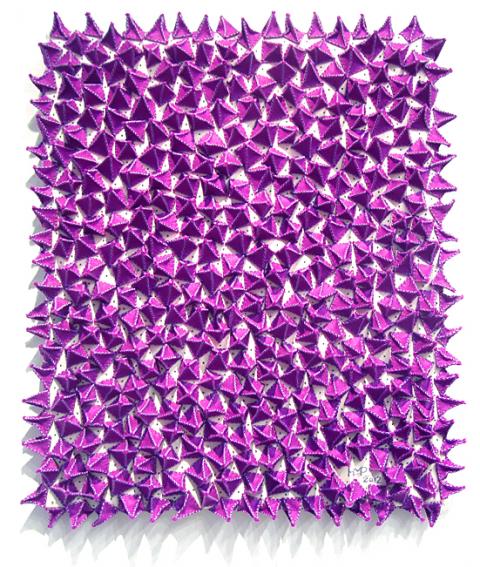Fungi, sea anemones, seeds and spores are among the natural phenomena Pan Hui-mei (潘惠玫) depict in her solo exhibition Multiply (繁衍). The show brings together 14 of her recent fabric creations, which meditate on biological processes and cellular phenomena, some of which look like they might be experiments in a petri dish or living organisms as seen under a microscope. Pan begins with a shape that she then randomly affixes to the canvas and gradually “multiplies,” as if like growing bacteria.
Though perhaps classifiable as paintings, the three-dimensional weaved shapes — pyramids, spheres, rods, discs — make them more akin to sculpture. The artist has said that her works were inspired by the environmental installations of Andy Goldsworthy and the monotone geometrical sculptures of Louise Nevelson.
■ Singart (新心藝術館), 67 Shengli Rd, Tainan City (台南市勝利路67號), tel: (06) 275-3957. Open Tuesdays to Sundays from noon to 8pm, closed Mondays and every second and fourth Sunday of each month

Photo courtesy of pan hui-mei
■ Until May 19

Photo courtesy of pan hui-mei

Photo courtesy of pan hui-mei

Photo courtesy of pan hui-mei

Photo courtesy of pan hui-mei

Photo courtesy of pan hui-mei

In the March 9 edition of the Taipei Times a piece by Ninon Godefroy ran with the headine “The quiet, gentle rhythm of Taiwan.” It started with the line “Taiwan is a small, humble place. There is no Eiffel Tower, no pyramids — no singular attraction that draws the world’s attention.” I laughed out loud at that. This was out of no disrespect for the author or the piece, which made some interesting analogies and good points about how both Din Tai Fung’s and Taiwan Semiconductor Manufacturing Co’s (TSMC, 台積電) meticulous attention to detail and quality are not quite up to

Chinese Nationalist Party (KMT) Chairman Eric Chu (朱立倫) hatched a bold plan to charge forward and seize the initiative when he held a protest in front of the Taipei City Prosecutors’ Office. Though risky, because illegal, its success would help tackle at least six problems facing both himself and the KMT. What he did not see coming was Taipei Mayor Chiang Wan-an (將萬安) tripping him up out of the gate. In spite of Chu being the most consequential and successful KMT chairman since the early 2010s — arguably saving the party from financial ruin and restoring its electoral viability —

It is one of the more remarkable facts of Taiwan history that it was never occupied or claimed by any of the numerous kingdoms of southern China — Han or otherwise — that lay just across the water from it. None of their brilliant ministers ever discovered that Taiwan was a “core interest” of the state whose annexation was “inevitable.” As Paul Kua notes in an excellent monograph laying out how the Portuguese gave Taiwan the name “Formosa,” the first Europeans to express an interest in occupying Taiwan were the Spanish. Tonio Andrade in his seminal work, How Taiwan Became Chinese,

Toward the outside edge of Taichung City, in Wufeng District (霧峰去), sits a sprawling collection of single-story buildings with tiled roofs belonging to the Wufeng Lin (霧峰林家) family, who rose to prominence through success in military, commercial, and artistic endeavors in the 19th century. Most of these buildings have brick walls and tiled roofs in the traditional reddish-brown color, but in the middle is one incongruous property with bright white walls and a black tiled roof: Yipu Garden (頤圃). Purists may scoff at the Japanese-style exterior and its radical departure from the Fujianese architectural style of the surrounding buildings. However, the property